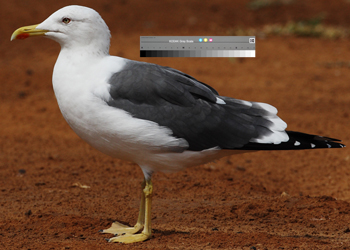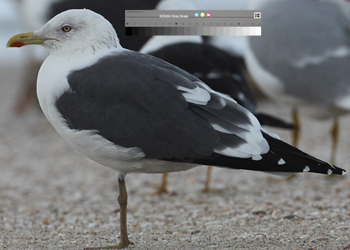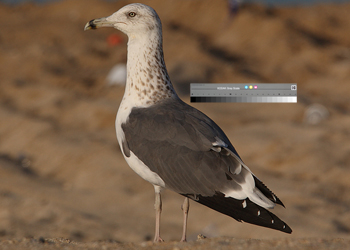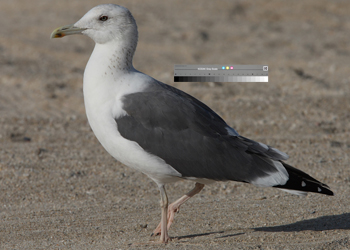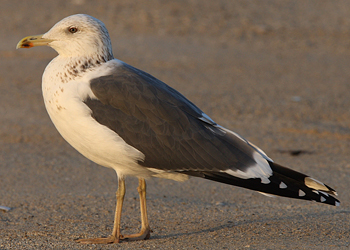 Heuglin's Gull (L. heuglini / antelius)
Heuglin's Gull (L. heuglini / antelius)
(last update:
Amir Ben Dov (Israel)
Chris Gibbins (Scotland)
Hannu Koskinen (Finland)
Mars Muusse (the Netherlands)
3cy heuglini: July

Coastline of Russkii Zavorot
peninsula, looking east. Water and wetlands dominate
this tundra, where thousands of karst and lagoon lakes with connecting channels allow
'West Siberian Gulls' Larus heuglini antelius to nest on isolated areas of land.
Below you will find a copy of Descriptive update on gull taxonomy: 'West Siberian Gull', by Valery A. Buzun published in British Birds 95 • May 2002 • 216-232. Most of the text below is a copy of that article, but now illustrated with many more birds and figures, and additional data from Dutch samples on breeding adult graellsii, which are very close in phenotypics.
"I" in the text below refers to the original author Buzun. If any errors occur in this text, please let me know and mail to marsmuusseatgmaildotcom.
PART 1 - INTRO & MANTLE COLOUR
PART 2 - PRIMARY PATTERN & BARE PART COLORATION
PART 3 - MORPHOMETRIC & DIMORPHISM
PART 4 - BODY SIZE
PART 5 - PRIMARY MOULT
PART 6 - GEOGRAPHICAL VARIATION
Descriptive update on gull taxonomy: 'West Siberian Gull' - Valery A. Buzun
PART 1
ABSTRACT Information on the appearance, behaviour and ecology of taxa
within the evolutionarily young 'large white-headed gull' complex (taxa
currently grouped by three species, Lesser Black-backed Gull Larus fuscus,
Herring Gull L. argentatus and Yellow-legged Gull L. cachinnans) is of interest
to those ornithologists who study their identification, systematics and
speciation. A sharp discrepancy has arisen between the demand for information about some of these taxa and the lack of elementary primary
data.The delay in gathering data is due to the inaccessibility of the breeding
grounds of some forms and to difficulties with systematic methodologies
within the group. There is a critical lack of information about three forms in
particular:'West Siberian Gull' L. heuglini antelius,'Taimyr Gull' L. h. heuglini
(= 'taimyrensis') and 'Baraba Gull' L. cachinnans barabensis.
This paper presents data on the plumage, biometrics, sexual dimorphism
and geographical variation of West Siberian Gull.The identification of the
Stuttgart type-specimen of heuglini is reviewed. It is suggested that this
specimen is, in fact, a Taimyr Gull, and that West Siberian Gull should,
therefore, be reassigned the subspecific name 'antelius'.
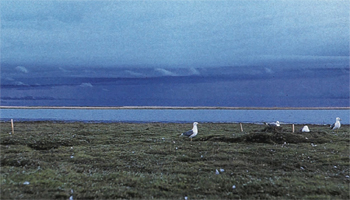 |
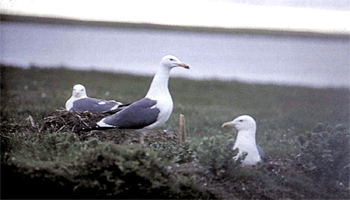 |
Colony of 'West Siberian Gulls' Larus heuglini antelius, Russkii Zavorot peninsula, Malozemel'skaya Tundra, Russia, June 1996.`This colony is in the coastal part of the peninsula, on a 1,8-ha lake islet. Distance between nests can be as little as |
|
The basis for the designation of a species or a subspecies is the original description of its morphological characteristics and biometrics. Subsequent to that original description, and with the accumulation of further data, new characters may be found and it may be recognised that some of the criteria by which a particular taxon was defined are invalid. Leaving aside moments of real discovery, our knowledge is based on the accumulation of observation and experiment. Subjective errors are part of the learning process.
Despite innovations in biological methods, and the large amount of new information which results from them, intuition and morphological classification remain essential in the field of modern systematics. Large numbers of professional zoologists and other interested parties will never be satisfied solely by the contributions made to systematics by molecular biologists and ethologists. Although advanced methods produce generally reliable results, traditional methods which base classification on physical morphology meet the needs of the majority of fieldworkers. The paradigm that all individuals of a taxon conform to the ‘type` has long been replaced in science by the idea that, although different taxa may appear to be discrete, individuals within each taxon are potentially variable. Against the background of brilliant innovations in molecular biology, the collection of morphological data is a fundamental part of systematics.
For some taxa, however, the initial descriptive work is weak and, owing to the limited availability of data, progress is either extremely slow or non-existent. This may occur when the taxa of interest are located in an area which is geographically isolated, or where local administrative problems obstruct researchers. These difficulties are exacerbated if the taxa concerned have only recently diverged from each other. Such a situation, whereby sibling or closely related taxa suffer from a paucity of descriptive data, inevitably results in disagreements among scientists. The activities of enthusiastic amateur taxonomists and fieldworkers, keen to publish their own research, lead to the risk of unsupported hypotheses being introduced into the scientific literature.
 Just such a difficult situation has developed with respect to the evolutionarily young `large white-headed gulls’ in the genus Larus (the complex of taxa currently grouped by three species: Lesser Black-backed Gull L. fuscus, Herring Gull L. argentatus and Yellow-legged
Gull L. cachinnans). Systematists face particular difficulties in this case because of the lack of high-quality primary data. The variety of taxonomic decisions affecting this complex of some 25-35 forms has become paradoxical, such that it appears that all possible combinations of phylogenetic arrangements have been proposed. Kist (1961) described the situation as ‘Babylonic’. For those who try to understand the problems posed by these gulls from the data in the literature, there are opportunities to accept or reject, defend or refute, any selected taxonomic position. The real data on which opinions are formed are, however, often limited, and the subsequent proliferation of working hypotheses is not constructive, owing to the impossibility of verifying them in the light of the available facts.
Just such a difficult situation has developed with respect to the evolutionarily young `large white-headed gulls’ in the genus Larus (the complex of taxa currently grouped by three species: Lesser Black-backed Gull L. fuscus, Herring Gull L. argentatus and Yellow-legged
Gull L. cachinnans). Systematists face particular difficulties in this case because of the lack of high-quality primary data. The variety of taxonomic decisions affecting this complex of some 25-35 forms has become paradoxical, such that it appears that all possible combinations of phylogenetic arrangements have been proposed. Kist (1961) described the situation as ‘Babylonic’. For those who try to understand the problems posed by these gulls from the data in the literature, there are opportunities to accept or reject, defend or refute, any selected taxonomic position. The real data on which opinions are formed are, however, often limited, and the subsequent proliferation of working hypotheses is not constructive, owing to the impossibility of verifying them in the light of the available facts.
A more fruitful approach to the understanding of phylogeny and speciation of large gulls is not to build on existing data (with all its accumulated errors), but to undertake a complete programme of laboratory and field research covering all the gulls in the complex. In the face of conflicting results, enthusiastic ornithologists may oversimplify or misinterpret the data obtained by their own research or from the literature, as discussed by Chylarecki (1993) and Yésou et al. (1994). Disagreements will not be resolved until large amounts of data can be collected by ornithologists handling gulls of undisputed identity on the breeding grounds. Discussion of several taxa is hindered by the predominance of data from the wintering grounds, where the accuracy of identification is doubtful and cannot be confirmed.
Within the large white-headed gull complex, Heuglin’s Gull [L. heuglini] has been so little studied that experts are sometimes compelled to warn against the mythology surrounding it (Hario 1992). It is a large, dark-mantled gull which breeds in the Arctic region between the White Sea and the Yenisei River. The type-specimen is in Stuttgart, Germany, although its identity is controversial (see Appendix on page 231).
Heuglin`s Gull has been variously designated as a subspecies of Herring Gull L. argentatus heuglini (e.g. Vaurie 1965; Grant 1986) or of Lesser Black-backed Gull L. fuscus heuglini (Cramp & Simmons 1983). It has also been regarded as a separate species comprising two races, the `West Siberian Gull’ L. h. heuglini and the ‘Taimyr Gull’ L. h. taimyrensis, which is the treatment that I adopt in this paper.
The aim of my current research is to determine the limits of variability in morphology, plumage patterns and biometrics of the various forms in the large white-headed gull complex, and to ascertain the areas in which these characters do not overlap. In the present paper I deal with the West Siberian Gull. In an appendix, I argue that the type-specimen is, in fact, an example of Taimyr Gull, and that the West Siberian Gull should be named L. h. antelius, following Iredale (1913). In the following text, the West Siberian Gull is referred to as antelius and the Taimyr Gull as heuglini. I shall also refer to the Armenian Gull L. armenicus simply as armenicus and to the ‘Baraba Gull’ L. cachinnans barabensis as barabensis. Approximate breeding ranges of some of these forms were described by Grant (1986).
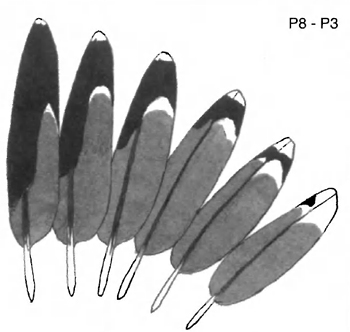 Materials and methods
Materials and methods
Between 1987 and 1996, I carried out research into the morphology and behaviour of yellow-legged forms of large white-headed gulls. Where possible, I caught and examined live birds. On the northern Taimyr peninsula, in southwest Siberia, and on the Russkii Zavorot peninsula (Malozemel’skaya Tundra), some gulls were killed with alpha-chloralose, in accordance with appropriate local guidelines, and the fresh specimens were processed. In addition, skins from the Zoological Museum of Moscow State University were examined. The nature of the study, looking at very similar and recently diverged forms, means that large numbers of individuals have to be examined in order to obtain statistically significant morphological data. Not all of my samples are sufficiently large.
A precise estimate of mantle colour was achieved, based on Voous (1959, 1961) and using the grey scale from the colour standards of Ridgway (1912, table 53, L111). For each individual gull, mantle colour was assigned to a defined shade of grey or given an intermediate value between two shades (table 1). A quantitative estimate of the colour pattern of the primaries was also made (table 2). Goethe’s (1961) technique, used for classifying the primaries of argentatus and cachinnans, was found not to be suitable for the Siberian dark-mantled gulls.
Details of measurements taken to record the extent of black pigment in the primaries are illustrated in fig. 1, and data for antelius are presented in table 3. To control for size differences between taxa and for sexual dimorphism within taxa, four indices were calculated (i1-i4): these represent the extent of black pigment per 1 mm of wing length on the external (i1 = a10/WL) and internal (i2 = b10/WL) webs of the outermost primary (P10) and on the external (i3 = a9/WL) and internal (i4 = b9/WL) webs of P9.
Thirty-seven adult West Siberian Gulls were obtained near the nests on the Russkii Zavorot peninsula and Chayachii Island (68°21’N, 53°49’E), and four second-years and one first-year were shot on the Zakhar’in coast. Measurements were taken with a ruler to an accuracy of 1 mm, or with callipers to an accuracy of 0.05 mm, for the following; wing length, flattened and stretched (WL); humerus (HL); ulna from olecranon to the labrum condyli (UL); sternum from the apex to the edge of the cartilage at the caudal end (S); tail (C); tarsus (TL); middle toe without nail (MTL); length of skull from the crista frontalis interior to the tip of the bill [equivalent to head + bill] (KDB); length of bill from border of feathering (BL1); length of bill from front edge of nostril (BL2); vertical depth of bill from tip of gonys to the culmen, without compression (BH1); inclined depth of bill perpendicularly from the proximal side of the gonydeal angle to as far as the culmen (BH2); vertical depth of bill at level of rear of nostrils (BH3); width of bill at level of rear of nostrils (BW).
As a criterion for the estimation of body size, individuals with intestines empty were weighed to the nearest 5 g (M). The mass of a gull varies seasonally, being lowest in summer during the nestling-feeding period (Barth 1967). The majority of specimens for this study were judged to be close to the final stages of incubation.

Results
Plumage and bare-part characteristics of adult and subadult antelius
Mantle colour
A standardised estimate of the shade of grey on the mantle of antelius, using Ridgway’s (1912) colour standards, showed that antelius is darker than most other forms in the large white-headed gull complex (table 1). The mantle and wings of antelius exhibit none of the bluish tones which are characteristic of argentatus. The form antelius can, therefore, be grouped with three other taxa which have a slaty-coloured mantle, namely heuglini, barabensis and armenicus. As a result of an incomplete pre-breeding moult, 31% of breeding individuals from the Russkii Zavorot peninsula retained old, unmoulted feathers which lent a brown cast to the mantle.
Stegmann (1934) characterised the average mantle colour of antelius but did not specify the range of variation. Devillers (1983) and Grant (1986) suggested that antelius was darker (close to Lesser Black-backed Gull of the race graellsii over much of its range) than it really is.
{By this last sentence, Buzun places antelius on the pale side of the Lesser Black-backed Gull spectrum, in fact paler than graellsii. If this is what he means, West-European birders should check birds that look pale for graellsii, and almost matching michahellis (except for the blue tone found in michahellis). How much paler than graellsii exactly, is not mentioned in the text by Buzun, but if you follow this reasoning, it is easier to understand why he groups antelius together with heuglini (taimyrensis), barabensis and armenicus. At first glance this looks strange, especially to people who visited the wintering grounds in the Middle East. Pictures from e.g. Israel show antelius to be a few shades darker than the michahellis-grey armenicus that can be found side-by-side. Note Mars Muusse}
| table 1 (Buzun, 2002): Indices of mantle colour of 'West Siberian Gull' Larus heuglini antelius from Kanin, the Russkii Zavorot peninsula and the Gulf of Ob, Russia (Kanin sample includes one individual from northern River Dvina). Terms used for colour shades follow Ridgway (1912). | |||||
Locality |
No. |
Mean mantle shade |
S.D. |
Mode |
Limits |
Kanin |
5 |
12.2 (>Slate Grey) |
0.45 |
- |
- |
Russkii Zavorot |
40 |
11.4 (Slate Grey) |
1.17 |
11 |
8-13 (>Deep Gull Grey-Slate Colour) |
Ob |
15 |
9.6 (>Dark Gull Grey) |
0.98 |
9 |
8-11 (>Deep Gull Grey-Slate Grey) |
| Notes: mantle shade of total sample between Kodak grey 8-13. | |||||
[Most field guides mention the upper part grey tone of antelius to match graellsii in a large way, and do not plot the grey tone in the paler end. Klaus Malling olsen & Hans Larsson in Gulls of North America, Europe and Asia write: Adult {antelius}: Almost indentical to Lesser Black-backed Gull race graellsii. Upperwing dark slate (Kodak Grey Scale 8-11), with blacker primaries.
From the same authors: L.f. graellsii: Upperparts pale slate-grey (Kodak Grey Scale 8-10(11))... L.f. intermedius: grades into graellsii, but in darkest birds upperparts blackish-grey to sooty-grey (Kodak Grey Scale 11-13), gaining slaty, or in darkest birds brownish tinge to wear. Addition Mars Muusse]
[Addition Mars Muusse; In the Netherlands, we sampled birds on the large industrial complex at Moerdijk (51.41N 04.36E). All sample birds were trapped at the nest using walk-in cages, as described in Sibly (1983). The nests were selected randomly. Species were separated using the combination of leg colour in combination with upper-part grey tone and orbital ring. Individuals were sexed in the field using head and wing measurements, as Niethammer (1937), Harris and Hope-Jones (1969) and Coulson et al (1983). We scored the upper-part grey tone and primary moult score of each bird in the field. Upperwing, underwing, legs and head were all photographed, with images examined afterwards in Photoshop (CS2) to characterise each bird according to 11 features.
Grey tone of upper-parts was scored 1-20 on Agfa Grey Scale (which is similar to the Kodak 20 step grey scale) in 0.5 classes. See Goethe (1961) and Jonsson (1998) for discussion of the use of grey scales and measurements. We first scored grey tone in the field (in the shadow) and photographed each bird with the scale held next to its wing, to optimise parallel light conditions for feathers and grey scale simultaneously (see example). Data were then validated from the photographs, using Photoshop ‘grey scale’ mode to correct for brown hue and chroma.
Results: a total of 888 Lesser Black-backed Gulls and 3 hybrids were plotted for Moerdijk, the Netherlands.
The modal grey tone for Lesser Black backed Gull was 11, with range 8-15. The three hybrids scored 7.0, 8.5 and 8.5.
From our findings at Moerdijk, the Netherlands, we conclude there is a full overlap in upperpart grey tones between Dutch graellsii and antelius from N. Russia.
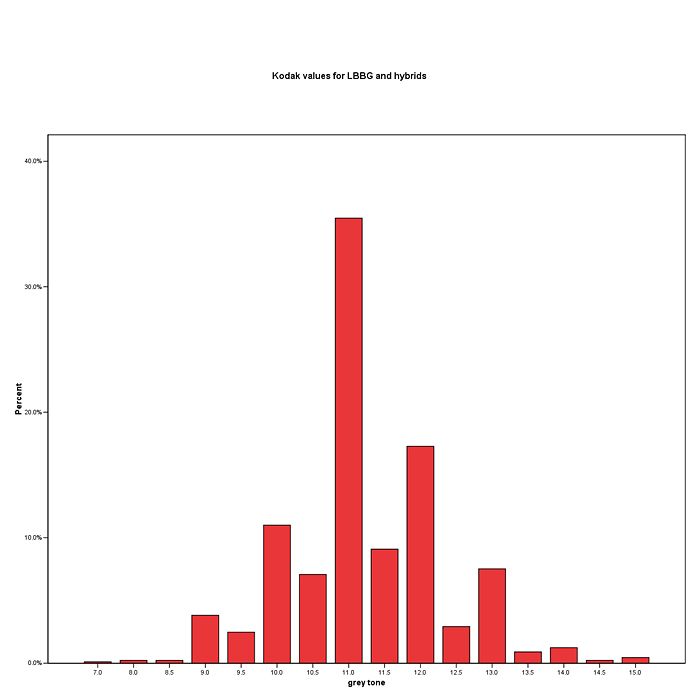
 heuglini 3cy, mid-July 2003, Tampere, Finland (61.33N 24.59E). Complete
moult started.
heuglini 3cy, mid-July 2003, Tampere, Finland (61.33N 24.59E). Complete
moult started. heuglini 3cy, mid-July 2003, Tampere, Finland (61.33N 24.59E). Many
barred 2gen coverts. Pale grey bird.
heuglini 3cy, mid-July 2003, Tampere, Finland (61.33N 24.59E). Many
barred 2gen coverts. Pale grey bird. heuglini 3cy, mid-July 2003, Tampere, Finland (61.33N 24.59E). Complete
moult started.
heuglini 3cy, mid-July 2003, Tampere, Finland (61.33N 24.59E). Complete
moult started. 
